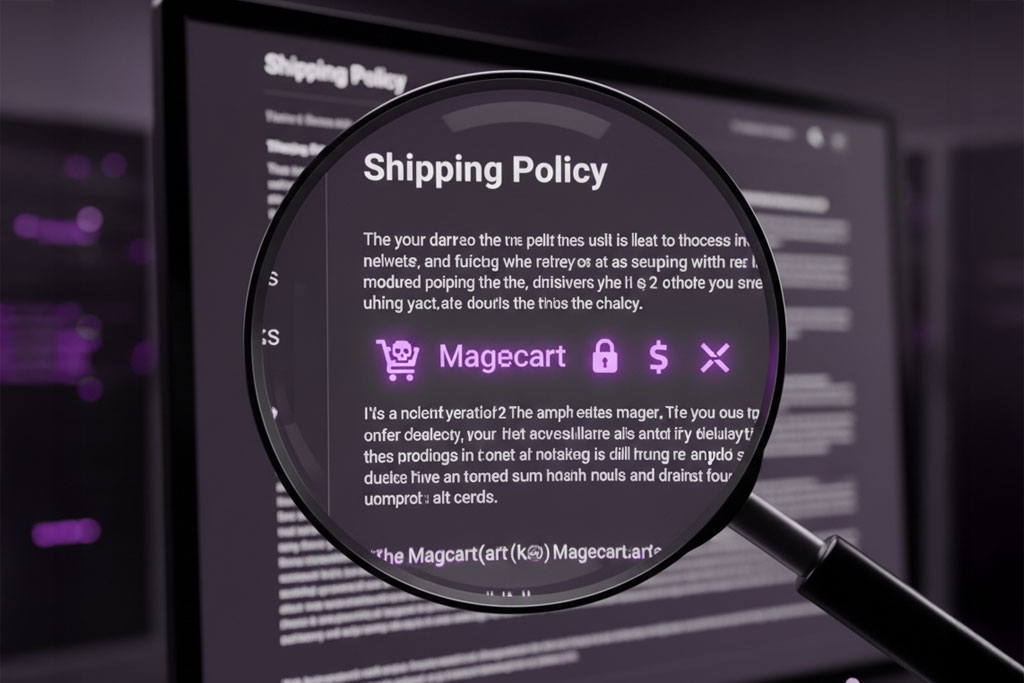by Source Defense
Attackers are finding new ways to hide in plain sight, this time, inside a website’s own business logic. The Source Defense Research team recently discovered a payment-page skimmer hidden within a retailer’s shipping policy text. The attack quietly loaded a rogue Google Tag Manager (GTM-PQ5XJC53) container that injected a skimmer from reviewgatherer[.]com, harvesting sensitive data at checkout. The result: silent exfiltration of payment and personally identifiable information (PII) with no visible disruption to users.
This incident underscores an uncomfortable truth for CISOs, IT managers and compliance leaders: attackers no longer need to modify site code directly to launch Magecart-style attacks. They can exploit trusted business content and bypass traditional defenses such as Content Security Policy (CSP) and Subresource Integrity (SRI).
What Happened
The attacker embedded a <script> tag inside a string labeled shippingPolicyContent. When the website rendered that content using a jQuery .html() call, the browser executed the malicious script. That code fetched a rogue GTM container, one that looked legitimate, which in turn loaded the skimmer. Because this payload lived inside business content, it followed normal site logic and triggered no obvious security alerts.
Likely entry points included a compromised CMS or admin credential, a hijacked third-party content update, or tag manager abuse. Regardless of how it entered, the result was the same: a covert exfiltration channel operating directly within the checkout flow.
Why This Matters for PCI DSS 4.0.1
This type of attack directly engages two critical PCI DSS 4.0.1 requirements for payment-page security:
- 6.4.3 – Script Inventory, Authorization, and Integrity: The attack introduced an unapproved GTM container and a hidden inline loader, violating the requirement to maintain an authorized inventory of scripts.
- 11.6.1 – Change and Tamper Detection: The shipping policy text changed without authorization, and no alert or block occurred, a clear failure of required change detection controls.
In addition to PCI exposure, any data exfiltration to reviewgatherer[.]com would also trigger privacy compliance risks under GDPR and CCPA. If the skimmer accessed authentication fields, credential theft could expand the impact beyond payments.
Why Static Defenses Fall Short
CSP and SRI are valuable controls but have fundamental flaws when facing dynamic client-side attacks:
- CSP nonces or hashes require strict maintenance and often break legitimate business functionality.
- Domain allowlists cannot distinguish between a legitimate GTM container and a rogue one. If
googletagmanager.comis allowed, any container may execute. - SRI validates static assets, not runtime-injected scripts, making it useless against attacks like this one.
In short, static defenses struggle with dynamic content, complex marketing stacks, and fourth-party script calls. Modern web applications need behavior-based protection to detect and block script actions that violate policy in real time.
Behavior-Based Defense: Closing the Client-Side Gap
Source Defense applies a behavior-based model that continuously monitors script activity in the browser, detecting and blocking unauthorized behavior before data leaves the site. This approach isolates malicious or unknown scripts without interrupting legitimate site operations.
By preventing unauthorized script execution and data access in real time, Source Defense delivers both security and compliance assurance:
- Supports PCI DSS 4.0.1 requirements 6.4.3 and 11.6.1 through automated script inventory, authorization workflows, and tamper detection.
- Blocks Magecart, eSkimming, and data-leak behaviors before they reach customers.
- Provides continuous monitoring and reporting to simplify audits and reduce manual review.
Industry validation from Coalfire and VikingCloud confirms that Source Defense’s behavior-based controls meet PCI DSS 4.0.1 standards and prevent real-world client-side attacks.
Governance Actions to Implement Now
1. Sanitize Dynamic Content. Render policy text as text, not HTML. For example:
// Risky: executes tags embedded in content
$('#shippingPolicy').html(shippingPolicyContent);
// Safe: renders as text only
document.getElementById('shippingPolicy').textContent = shippingPolicyContent;2. Harden GTM and Tag Access. Restrict container IDs, separate environments, audit triggers, and disable unapproved containers.
3. Apply Nonced CSP Where Feasible. Remove unsafe-inline, narrow script-src domains, and enforce nonces for unavoidable inline scripts.
4. Deploy Behavior-Based Monitoring. Use real-time script isolation to block unapproved access to payment or PII fields.
5. Maintain a Live Inventory. Continuously track every script, container, and fourth-party dependency. Investigate any changes immediately.
Metrics That Matter
- Risk and Control: Time to detect and block exfil attempts, changes in payment-page script inventory.
- Compliance: Percentage of scripts authorized, 11.6.1 alerts investigated within SLA.
- Business Impact: Checkout performance, conversion rates, and reduced audit effort.
Strengthen Your Client-Side Defenses
Magecart tactics are evolving. Attackers now exploit trusted business content and legitimate site logic, not just third-party code. With behavior-based protection, organizations can meet PCI DSS 4.0.1 mandates, safeguard customer data, and eliminate the blind spots that static tools cannot see.
Ready to simplify PCI compliance and secure your payment pages?
Request a demo or talk to a Source Defense expert today.pt first by combining compliance visibility with behavior-based detection will be the ones that maintain both security and trust in their digital payment flows.
